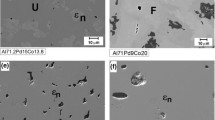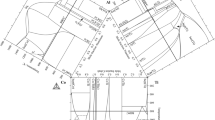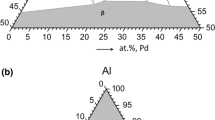Abstract
Al68Pd14.6Co17.4, Al69.8Pd13.8Co16.4, Al72Pd12.8Co15.2, Al73.8Pd11.9Co14.3, and Al76Pd11Co13 alloys annealed at 700 ∘C for 2000 h were studied. In the investigation, scanning electron microscopy including energy dispersive X-ray spectroscopy and electron backscatter diffraction, X-ray diffraction, and transmission electron microscopy were used. Altogether five near-equilibrium phases (β, U, Al5Co2, ε, Al9Co2) were identified. Transitions between β, U, and ε phases were also determined dependent on the alloy bulk metal composition. The experimental results were used to propose the partial isothermal section of the Al–Pd–Co phase diagram at 700 ∘C. The maximum solubilities at 700 ∘C of Pd in Al9Co2 and Al5Co2 were determined as 1.7 and 2.69 at.%, respectively.
Access provided by Autonomous University of Puebla. Download conference paper PDF
Similar content being viewed by others
Keywords
These keywords were added by machine and not by the authors. This process is experimental and the keywords may be updated as the learning algorithm improves.
18.1 Introduction
Structurally complex phases consisting of large cluster-base unit cells are attributed to complex metallic alloys (CMA) inclusive of ternary Al-base CMAs [1–5]. In the Al–Pd–Co alloys, more structurally complex phases were observed [6–11], e.g., the ternary monoclinic U-phase or orthorhombic phases of the ε-family. The latter phases can be classified as either binary phases alloyed with the third element (ε 6 and ε 28) or ternary phases (ε 22 and ε 34) [12]. Yurechko et al. [6, 7, 9, 11] studied phase equilibria in the Al–Pd–Co system and published isothermal sections of the related phase diagram at 1050, 1000, 940, and 790 ∘C.
In the present work, five ternary alloys (Al68Pd14.6Co17.4, Al69.8Pd13.8Co16.4, Al72Pd12.8Co15.2, Al73.8Pd11.9Co14.3, and Al76Pd11Co13) were long-term annealed at 700 ∘C and the near-equilibrium phases formed were characterized. The experiment was done with the intention to propose a partial isothermal section of the Al–Pd–Co phase diagram at 700 ∘C still missing in the literature.
18.2 Experimental Procedures
The investigated alloys were prepared by arc melting of pure components under argon atmosphere. After casting, the samples were annealed at 700 ∘C for 2000 h and rapidly cooled in water to fix their high-temperature microstructure.
In the investigation, scanning electron microscopy (SEM) including energy dispersive X-ray spectroscopy (EDX) and electron backscatter diffraction (EBSD), X-ray diffraction (XRD), and transmission electron microscopy (TEM) were used. For XRD a Philips PW 1830 diffractometer with Bragg–Brentano geometry was selected using iron filtered Co Kα1 radiation, scattering angle 2θ ranged between 5 and 70∘, step size was 0.02∘, and exposure time was 10 s per step. For SEM a JEOL JSM-7600F microscope was used equipped with an EDX spectrometer X-max working with INCA software and an EBSD Nordlys detector working with FLAMENCO software. At least 10 measurements per microstructure constituent were performed to determine their metal compositions. To calculate volume fractions of microstructure constituents an ImageJ software was used. The identification of phase by selected-area electron diffraction (SAED) was performed in a JEOL 2000FX microscope operating at 200 kV.
18.3 Results
The results of the characterization of near-equilibrium phases present in particular alloys are summarized in Table 18.1. Each of the observed microstructure constituents was found to consist of a single phase. For instance, the single-phase constituents observed in the Al76Pd11Co13 alloy (Fig. 18.1) were identified as ε and Al9Co2 (Fig. 18.2). Altogether five phases were found in the investigated alloys. Monoclinic U, cubic β, orthorhombic ε, and monoclinic Al9Co2 were identified by XRD because their volume fractions were detectable for this technique (compare Table 18.1 and Fig. 18.2). These phases were also identified by SAED/TEM as documented in Fig. 18.3 for β. For the identification of hexagonal Al5Co2 appearing in extremely small amounts in Al68Pd14.6Co17.4 and Al69.8Pd13.8Co16.4 alloys, the EBSD/SEM technique was used (Fig. 18.4). Metal compositions and volume fractions of the identified near-equilibrium phases are also given in Table 18.1.
18.4 Discussion
The experiments were done with the aim to find correlations between the microstructure constituents (SEM), the identified near-equilibrium phases (XRD, SAED/TEM, EBSD/SEM), as well as metal compositions (EDX/SEM) and volume fraction (SEM) of the identified phases. Bulk metal compositions of the investigated alloys were selected with the intention to hold the Pd/Co-ratio constant. Thus, an increase in the Al bulk content was accompanied by a decrease in both Pd- and Co-bulk contents. As follows from Fig. 18.5, there is a correlation between the bulk Al content and the occurrence of dominant phases in the investigated alloys. The increase in the Al bulk content from 68 to 76 at.% evoked β+U→U→U+ε→ε phase transitions. This shows that Al stabilizes mainly ε and Pd+Co stabilize mainly β in the investigated alloys. Moreover, the Al contents in both U and ε were found to increase slightly with increasing the bulk Al content in agreement with [6–8].
The partial isothermal section of the Al–Pd–Co phase diagram (in the next text shortly “diagram”) at 700 ∘C (Fig. 18.6) was proposed with respect to both own experimental results and the diagram published by Yurechko for 790 ∘C [7]. Positions and sizes of single-phase ε and U areas were modified only slightly. The double-phase ε+U area became wider. The positions of ε+Al9Co2 and U+β+Al5Co2 areas are extended towards the higher Pd contents. Dashed lines were used when experimental results were not available. The F-phase was not found experimentally after long-term annealing at 700 ∘C. It confirms the trend reported in [7, 8] that F disappears gradually with decreasing temperature. This happens probably between 790 and 700 ∘C. Several binary Al–Co and Al–Pd phases exhibit extensions into the ternary compositional area. At 700 ∘C, the maximum solubilities of Pd in Al9Co2 and Al5Co2 were determined as 1.7 and 2.69 at.%, respectively. Congruent AlCo and AlPd phases of the CsCl-type were found to form continuous set of β-Al (Pd, Co) solid solutions [7–9].
18.5 Conclusions
In the investigated Al68Pd14.6Co17.4, Al69.8Pd13.8Co16.4, Al72Pd12.8Co15.2, Al73.8Pd11.9Co14.3, and Al76Pd11Co13 complex metallic alloys, altogether five near-equilibrium phases (β, U, Al5Co2,ε, Al9Co2) were identified after annealing at 700 ∘C for 2000 h. The microstructure constituents, their metal compositions, and volume fraction were assigned to the near-equilibrium phases identified. The increase in the bulk Al content from 68 to 76 at.% was found to evoke β+U→U→U+ε→ε phase transitions. The partial isothermal section of the Al–Pd–Co phase diagram at 700 ∘C was proposed based on the experimental results. The maximum solubilities at 700 ∘C of Pd in Al9Co2 and Al5Co2 were determined as 1.7 and 2.69 at.%, respectively.
References
Wang N, Fung K, Kuo KH (1988) Symmetry study of the Mn–Si–Al octagonal quasicrystal by convergent beam electron diffraction. Appl Phys Lett 52:2120–2121
Beeli C, Nissen HU, Robadey J (1991) Stable Al–Mn–Pd quasi-crystals. Philos Mag Lett 63:87–95
Dubois JM (2001) Quasicrystals J Phys Condens Matter 13:7753–7762
Okabe T, Furihata JI, Morishita K, Fujimori H (1992) Decagonal phase and pseudo-decagonal phase in the Al–Cu–Cr system. Philos Mag Lett 66:259–264
Mihalkovič M, Zhu WJ, Henley CL, Phillips R (1996) Icosahedral quasicrystal decoration models, II: optimization under realistic Al–Mn potential. Phys Rev B 53:9022–9044
Yurechko M, Grushko B (2000) A study of the Al–Pd–Co alloy system. Mater Sci Eng A 294:139–142
Yurechko M, Grushko B, Velikanova T, Urban K (2002) Isothermal sections of the Al–Pd–Co alloy system for 50–100 at% Al. J Alloys Compd 337:172–181
Raghavan V (2008) Al–Pd–Co. J Phase Equilib 29:54–56
Yurechko M, Fattaha A, Velikanova T, Grushko B (2001) A contribution to the Al–Pd phase diagram. J Alloys Compd 329:173–181
Matsuo Y, Hiraga K (1994) The structure of Al3Pd—close relationship to decagonal quasi-crystals. Philos Mag Lett 70:155–161
Yurechko M, Grushko B, Velikanova T, Urban K (2004) A comparative study of the Al–Co–Pd and Al–Co–Ni alloy system. J Alloys Compd 367:20–24
Frigan B, Santana A, Engel M, Schopf D, Trebin H-R, Mihalkovič M (2011) Low-temperature structure of ξ-Al–Pd–Mn optimized by ab initio methods. Phys Rev B 84:184203
Acknowledgements
The authors wish to thank to the European Regional Development Fund (ERDF) for financial support of the project ITMS:26220120014 “Center for development and application of advanced diagnostic methods in processing of metallic and non-metallic materials” funded within the Research & Development Operational Programme, to the Slovak Academy of Sciences for the support in the frame of the “Center of Excellence for functional multiphase materials“ (FUN-MAT), to the Slovak Research and Development Agency (APVV) for the financial support under the contract APVV-0076-11, as well as to the Grant Agency of the Ministry of Education, Science, Research, and Sport of the Slovak Republic and the Slovak Academy of Sciences (VEGA) for the financial support under the contracts 1/0143/12, 2/0111/11, and 1/0339/11.
Author information
Authors and Affiliations
Corresponding author
Editor information
Editors and Affiliations
Rights and permissions
Copyright information
© 2013 Springer Science+Business Media Dordrecht
About this paper
Cite this paper
Černičková, I., Čička, R., Švec, P., Janičkovič, D., Priputen, P., Janovec, J. (2013). A Study of Phase Equilibria in the Al–Pd–Co System at 700 ∘C. In: Schmid, S., Withers, R., Lifshitz, R. (eds) Aperiodic Crystals. Springer, Dordrecht. https://doi.org/10.1007/978-94-007-6431-6_18
Download citation
DOI: https://doi.org/10.1007/978-94-007-6431-6_18
Publisher Name: Springer, Dordrecht
Print ISBN: 978-94-007-6430-9
Online ISBN: 978-94-007-6431-6
eBook Packages: Chemistry and Materials ScienceChemistry and Material Science (R0)










